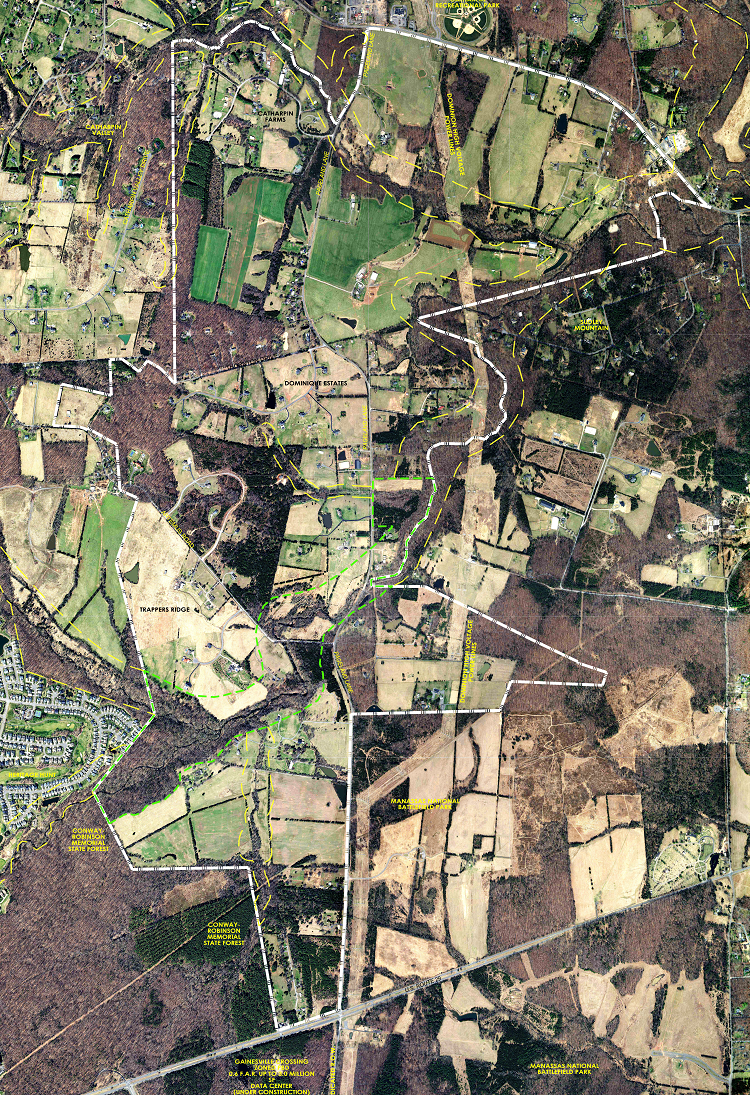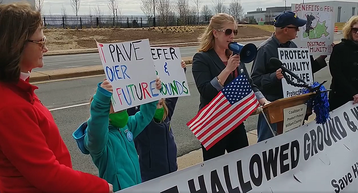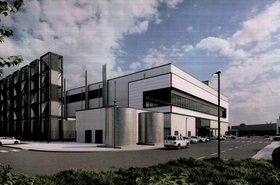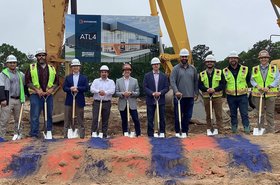Northern Virginia is the undisputed capital of data centers worldwide. A Cushman & Wakefield report suggests the market measures more than 1,600MW of installed capacity, more than double the next largest market.
Within that, Loudoun County is the epicenter; home to the “Data Center Alley” neighborhood, official figures suggest it currently has around 26 million sq ft of data centers across the whole county.
However, as Loudoun continues to fill, a number of developers are looking to expand to neighboring counties. Developments in Prince William are growing, and a new project could see thousands of acres rezoned, paving the way for tens of millions of square feet of new data center development.
Locals, however, are rallying against the proposals, as are others throughout the county and wider Northern Virginia.
Even if there is enough land and power, the residents may be reaching saturation point.
Prince William Digital Gateway - a new rival to Loudoun?
Reports surfaced last year of PW Digital Gateway, a development in Prince William County. First reports described an 800-acre development that would string together 30 parcels of agricultural land along Pageland Lane owned by 15 property owners, to be developed by a single unnamed data center developer.
Since then, the PW Gateway project has expanded massively to something that, if fully built out, could see Prince William overtake Loudoun as the data center hotspot of the world.
More than 200 landowners have elected to join the proposal; the current version of the project would replan 2,133 acres of the county's "Rural Crescent" for data centers. Approval could pave the way for up to 7.6 million square feet of data centers; more than all the facilities in Loudoun right now - and on top of other existing developments in PWC.
It’s worth noting, however, that even if the Gateway plan is approved, individual developments would still need planning permission; data center developments outside the county’s existing designated ‘Data Center Overlay Zone’ also need special permission.
The original developer for the 800-acre project was later revealed as QTS, when the company’s logo was spotted on slides shown at a town hall meeting. QTS confirmed this to the press: “QTS has been approached and is seeking to acquire land as part of the Prince William County Digital Gateway project,” a QTS spokesperson wrote in a statement to Prince William Times.
“This is a unique opportunity to play a role in what could be the most significant economic development initiative in the county’s history. QTS has a strong track record of being a considerate, supportive and sustainable neighbor and is committed to a thoughtful development strategy that will preserve the historical significance and aesthetic beauty of the area,” the statement continued. QTS declined to expand on these comments to DCD.
Not everyone was convinced by QTS, and protests focused on the Manassas National Battlefield, a historic Civil War site adjacent to the development. Around 50 people from the Coalition to Protect PWC gathered outside QTS facilities in Manassas, with chants and signs saying “stay out of the rural crescent” and “save our sacred battlefield.”
“We are here to say to QTS data centers…go away,” said Elena Schlossberg, executive director of the coalition, said at the event.
Schlossberg told DCD that, when QTS was revealed as the project backer, the Coalition thought: “We need to just let QTS know that, clearly, they haven't been paying attention to the concerns of the community.
“We needed to make sure that they hear us, and had the idea to have a press conference/little rally/introduction in front of the QTS building.”
QTS officials have not acknowledged the rally, on the day or subsequently.
“They didn't come out. They haven't reached out to us. Their response was to file the rezoning application. I think that they're hoping that we'll get tired and we'll go away, but we're not going anywhere.”
Update: Since this piece was written, Compass Datacenters has also filed its own application, requesting to rezone 824.9 acres across 103 properties along Pageland Lane, including the home of Gainesville Supervisor Pete Candland. The company wants to build 10.52 million square feet of data centers by 2030.
The projects combine to cover 1,636 acres and 18.42 million square feet of data centers, meaning another ~500 acres/9 million sq ft of data centers have yet to be publicly claimed.
The fight for Pageland
Local officials are yet to vote on the Digital Gateway proposals, but local residents and officials have voiced concerns over inviting large amounts of new development to a mostly rural area and worry about the potential impact the rezoning could have on the National Battlefield.
The fight has even made it to the national press, with the WSJ and Reuters reporting on the uproar from local residents, heritage & conservation groups, which even includes a local retirement home. A public hearing about the proposal in January lasted more than three hours and 73 people spoke.
Board of Supervisors Chair Ann Wheeler has warned that rural land doesn’t have guaranteed protection: “We can’t just take things off the table because it’s in an undeveloped rural area,” she said.
But there are other concerns. Parts of the development would disturb the graveyards of enslaved people dating from before the Civil War.
And the project could also impact local watersheds that run to the Occoquan reservoir – a major source of drinking water in the area.
“I call it the plunder of Pageland. You are always going to fight to protect your land in the rural area,” says Schlossberg, “because developers see it as empty space. They don't see it for its value, especially for its environmental resources and how we fight climate change.”
Brandon Bies, superintendent of the National Battlefield Park, has written to the Prince William Board of County Supervisors and the county planning office, outlining “grave concerns,” saying the plans could cause “potential irreparable harm” to the park’s historical, environmental, and visual aspects.
Documentary filmmaker Ken Burns has said the proposals could have a “devastating impact” on the National Battlefield.
Environmental officials at Prince William County asked the board of supervisors to reject the proposal, and US Rep. Jennifer Wexton, a Democrat representing Virginia’s 10th Congressional District – encompassing parts of Loudoun, Fairfax, and Prince William Counties – wrote to the Board of Supervisors last month. She said the proposal would have a “significant negative impact on the surrounding environment and community.”
Even those outside the county are wary of the proposals. In letters submitted to PWC, officials from neighboring Fairfax County laid out a series of objections to the land-use change.
“Fairfax County staff has significant concerns regarding the impacts that will accrue from adoption of this CPA (Comprehensive Plan Amendment) and encourages Prince William County to reconsider the proposal,” warned Fairfax County Officials in the letter, signed by Fairfax Planning Director Barbara Byron.
“We have an overarching concern about the proposal to permit higher density development within the larger Occoquan Watershed due to cumulative impacts on the reservoir which provides drinking water to a large portion of Northern Virginia,” the letter reads.
Loudoun County officials, by contrast, do not oppose the proposals.
PW County’s own finance projections suggest the proposals won’t generate as much tax revenue as previously thought. Prince William County Deputy Finance Director Tim Leclerc told county officials the Gateway would eventually generate about $400.5 million a year in local tax revenue under current tax rates – not the $700 million the project’s applicants estimate.
Leclerc also said this tax revenue would ramp up slowly, rising from about $9.8 million in the first year of operation, to $204 million in 10 years’ time, reaching about $336.8 million in year 15.
Another fight over developments in PWC
The Coalition to Protect PWC originally started around 2015 to oppose a proposed power transmission line. Dominion Energy was seeking to build a new line to serve an AWS facility in Haymarket. The case went to court and, eventually, the power line was partially buried.
“We told them it would be the most expensive transmission line fight they would ever experience and the longest, and we were right,” says Schlossberg.
The Coalition is now focused on fighting the PW Gateway project and protecting the Rural Crescent, arguing the County’s existing allocated land for data centers is sufficient.
“It's fun to be called an activist, but that's not really how I see myself. I see myself as someone who tries to inject common sense and rational growth patterns which are based on Smart Growth principles,” says Schlossberg.
“We just do it because we believe that what we leave behind matters. Anybody who's paying attention to climate change should be terrified that this is the direction that we're moving.”
As with many outside the industry, Schlossberg and the members of the coalition were not previously well-versed in the data center industry until facilities and the accompanying infrastructure started showing up on their doorsteps.
“We all live our lives in ignorant bliss. That was a big eye-opener and learning curve; I had to learn about megawatts and the load that could be handled at a substation, and transmission lines. It was surprising that we had not been having these discussions earlier. ”
The area in question along Pageland and close to Manassas Battlefield is called the Rural Crescent because it's designed as a rural barrier to prevent sprawling, uncontrolled development. The area has fought off several proposed developments over the years, most notably a major mall and a proposed Disneyland resort in the 1990s.
Referring to that battle. Schlossberg warned QTS: “You think Disney had it hard? Just wait.”
The Coalition first heard about the Gateway project when Dominion Energy alluded to it during a public meeting about another project outside the existing overlay zone.
The Coalition says the Council is now pro-development, and has lost interest in protecting PWC’s rural areas. PWC Council officials declined to speak to DCD for this piece.
Schlossberg says today the PW Gateway project is being led by several local landowners that have long had hopes of developing their plots – including some who previously opposed the likes of Disney – and have simply pivoted from residential or commercial towards data centers as the opportunity arose.
“They've abandoned the higher density development into the Rural Crescent and they've gone right for data center development,” says Schlossberg.
One who switched sides is County Supervisor Pete Candland, who opposed the proposals at first, but eventually joined the PW Gateway group. His home is in the development area and Candland says he has no choice but to sell, or see his home surrounded by data centers.
He is now excluded from participating in Board of County Supervisors discussions or votes on the proposal. Some locals called him to resign.
As landowners like Candland join up, the project has expanded from 800 acres to more than 200 landowners with 2,000 acres. The Coalition says the smaller landowners close to the larger plots leading the project feel compelled to join the project out of desperation.
“The developers spin this narrative that this is going to happen and you could either join them or see your home and your quality of life flushed down the toilet,” says Schlossberg. “The landowners can't talk anymore because they've subsequently signed an NDA, but we know people did not want to sign on.
“They don't want to sell, but they also feel trapped. If they have three acres and end up surrounded by these massive buildings and substations, their quality of life is going down. And that's what the developers did; convince people that either they were going to make a million dollars an acre, or, if they didn't buy-in, they would be doomed.
“I don't believe that you should screw your neighbor so that you can make a bunch of money. It's ripping apart the fabric of our community.”
The county has an existing data center overlay zone – an area where data centers are permitted and require less zoning and planning permission applications.
Proposed by the Coalition, the overlay zone aims to promote the development of data centers within areas of the County where there is existing infrastructure to support them. It is largely centered on the land between Manassas and Gainesville. The existing overlay encompasses around 10,000 acres, mostly in close proximity to high-voltage transmission lines. As of December 2021, approximately 500 acres of the land within the overlay is currently developed with data centers, An additional 1,600 acres are in preconstruction (permit review or planning stages) or under construction. A report from the review suggests approximately 600-1,110 acres of remaining land in the overlay are considered ‘market viable.’
The County is currently exploring whether or not the overlay zone should be expanded. This is another bone of contention with the Coalition, but is entirely separate to the PW Gateway project, and could see even more land in the county designated for data centers.
“[With the introduction of the overlay zone] we wanted to prevent that kind of thing from happening again,” says Schlossberg. “This new board has taken that effort with the overlay zone and they've crushed it beneath their feet and I don't know why. What a joke.”
Are Northern Virginia’s residents hitting data center saturation point?
Even beyond the Digital Gateway Project and the overlay zone, smaller fights against data center campus proposals are popping up both in PWC and neighboring counties.
Housing developer Stanley Martin is seeking to rezone more than 250 acres in PWC’s Bristow to allow for up to 4.25 million square feet (394,800 sqm) of data center development.
A neighboring plot has already been given the greenlight for a 1 million sq ft (93,000 sq m) data center campus, likely for Yondr. Locals opposed the proposals in the local press.
Another 80MW development in PWC’s Haymarket moved forward on a technicality after county officials couldn’t agree on whether the development should go ahead, especially before the results of the data center overlay review.
Near PWC’s Dale City, Plaza Realty Management Inc. is proposing a 1.16 million sq ft data center campus.
Culpeper County has eschewed data centers, aside from four Equinix data centers that opened 14 years ago, but it is now a target for AWS. The cloud giant wants to put up two buildings spanning up to 430,000 sq ft (40,000 sq m) on 243 acres of land in Stevensburg.
The county Planning Commission voted to recommend denying the application during a five-hour meeting that saw dozens of people speak and ran till after midnight. More than 40 people addressed the board during the next meeting, the vast majority against the proposal.
The plans were also opposed by State Sen. Bryce Reeves. The county still ruled in favor of the zoning change, but local residents are suing county officials to have the decision reversed.
Even Loudoun may be hitting its limit. The county is currently considering a rezoning proposal that could add another 56 million sq ft of potential data center space. But local officials have been hostile towards such proposals.
“If we turn this large chunk of land into data center alley… it would be totally opposite of the majority of public input we just got recently from our residents,“ said Loudoun County Supervisor Tony Buffington at a public hearing.
“I will fight this so hard, every step of the way,” he added, saying that if the current space zoned for data centers is all used up, “then maybe we have just run out of data center space.”
If the likes of Loudoun, Fairfax, and Prince William reject future developments, the surrounding areas could benefit. In Fauquier County, the town of Warrenton changed its zoning laws to allow for data centers after AWS expressed an interest in developing there. Neighboring Warren County is looking to amend its zoning laws to allow for data centers, as is Frederick County across the state line in Maryland. A number of counties in Southern Virginia have lowered their data center-related taxes in the hope to lure developers, while the state has reduced tax-incentive spending requirements in poorer areas of the state.
Back in Prince William, local officials were due to vote on the PW Digital Gateway project in April but have yet to make a decision at the time of publication. But even if the vote is passed – previous reports suggest the Council’s members are broadly in favor – opposition from local residents will continue.
“I don't think QTS understands the passion of this community,” says Schlossberg. “And I don't think that this new board does either. The overlay was adopted for a reason. We believe you don't have to sacrifice your natural resources, your environment, your hallowed ground, your clean drinking water, for economic development.
“It's not this Hobson's choice of either you have your environment or you have economic development. Sustainability begins with site selection. And when you have the local state and national conservation groups telling you you're in the wrong place, you're in the wrong place.”
“And I think that this is a time when data centers should really be trying to avoid this kind of community opposition. It's a bad look.”








